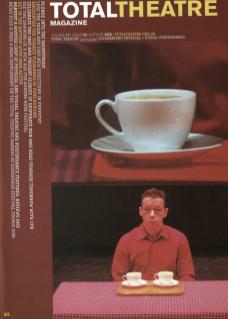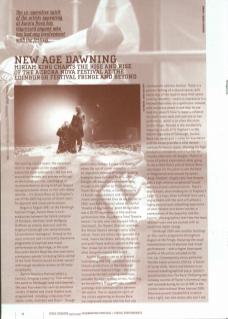The looming church tower, the expectant thrill in the queue on the steep steps before the show commences, the hubbub around the reviews and preview write-ups on the boards outside, catching up on recommendations during brief yet languid lounging between shows on the cafe tables outside... it's Aurora Nova at St Stephen's, one of the defining events of recent years for physical and visual performance.
Begun in August 2001 at the Edinburgh Festival Fringe, Aurora Nova is a co-production between the Fabrik company of Potsdam, Germany (with Wolfgang Hoffman as artistic director) and the Brighton/Edinburgh arts venue Komedia (as producers/managers). Viewed as the most coherent and consistently impressive programme of physical and visual performance on the Fringe, in the past four years Aurora Nova has won over thirty prestigious awards (including twice-winner of the Total Theatre Award for best venue) and enough excellent reviews to fill many scrapbooks.
Aurora Nova is a festival within a festival, bringing companies from all over the world to Edinburgh (and soon beyond). The past four years has seen an enormous variety of dance and visual theatre work programmed, including companies from Japan, India, Australia and Brazil – though particularly Eastern Europe and Russia where the use of visual metaphor is such an important element of theatre-making. Examples have included Derevo, who brought the beautiful and mesmerising Islands in the Stream to St Stephen's; Theatr Novogo Fronta, a Czech company of Butoh-esque dancers and acrobatic clowns who presented Dias de las Noches in 2004; and Akhe (Russia) whose wonderful ‘theatre of engineering' piece White Cabin was a 2D/3D experiment in film and live performance that won them a Total Theatre Award. I've also seen and enjoyed Fabrik (Germany), Do Theatre (Russia) and Nats Nus Dansa (Spain) amongst many other artists. These are artists who question the mind, inspire the heart, enliven the spirit and quiet those restless spaces in the soul. Their shows live on in the imagination well after the performance has ended...
Aurora Nova was set up to present outstanding and original visual and dance theatre productions at the Edinburgh International Festival Fringe – but also to provide the best working conditions possible for participating artists, fostering an environment that promotes creative exchange and communication between the artists. The cooperative spirit of the artists appearing at Aurora Nova has impressed anyone who has had any involvement with the festival. There is a genuine feeling of a shared space, with ownership of the need to keep that space running smoothly – and it is impressive in a festival that relies on a quick turn-around, with numerous shows in one day, to see that this doesn't have to mean a reliance on small-scale work with just one or two performers, which is so often the norm at the Fringe. Housed in the wonderfully imposing church of St Stephen's in the Stockbridge area of Edinburgh, Aurora Nova has developed a name for excellence and the venue provides a vital decent-sized performance space, allowing for high production standards and a facility for visually elaborate set designs. There's a sense of potent expectation when going to see a show that's part of Aurora Nova.. one knows it's the place to see the best in imaginative and unusual European 'Body-Theatre'; largely text-free theatre with a high reliance on physical/visual expression and communication. There's also a hope when heading for St Stephen's (and it's a hope often fulfilled) that one's engagement with the work will afford a highly sensual and compelling experience of what theatre and dance can be; a combination of the beautiful and the bizarre, choreographies that take the least obvious route and are packed with an emotional depth charge.
Edinburgh 2005 sees another bursting-at-the-seams programme throughout August at the Fringe, featuring the usual international mix of physical and visual performance – with a higher than usual profile of UK artists included in the line-up. Contemporary circus performer Matilda Leyser presents Lifeline, a fusion of aerial skills, dance and theatre in an unusual autobiographical piece. Gecko's second production The Race (following the runaway success of Taylor's Dummies) was well received during its run at BAC in the London International Mime Festival 2005. Rotozaza present Doublethink in which, every night, two new actors who can't see each other must gamely interpret the same instructions. Doublethink poses the provocative concept: 'It will work perfectly if you simply do what you're told.’ Absence and Presence is a solo performance from veteran mime/physical theatre performer Andrew Dawson (who directed the award winning Pandora 88 for Fabrik, which returns to Aurora Nova this year).
From elsewhere around the world come Compagnie Martine Pisani, Couch Potatoes' Paradise, Comuna Baires & Fare Anima, Jo Strømgren Kompani, and Rainpan 43 – whose All Wear Bowlers promises 'the desolation of Samuel Beckett, the mysterious beauty of Rene Magritte, and the pathos of Laurel and Hardy' which 'collide to create a surreal world of venomous ventriloquists and belligerent bowlers'.
But beyond the Fringe... the first step out of Edinburgh for the festival will be the Aurora Nova in the South, which is launched this autumn. The aim is for this to be an annual event. To start the ball rolling – this year, between 5th October and 12th November 2005, four companies will perform at Komedia and The Gardner Arts Centre in Brighton, with three of the companies also touring to other selected theatres in the South East region. This season will incorporate the 2nd International Producers Forum organised by Visiting Arts, which will take place at Komedia Brighton on Tuesday 11th October.
Wolfgang Hoffman's wide knowledge of international dance and visual theatre drives Aurora Nova and the festival is powered by the commitment from the Komedia team who produce it. This new venture is just the first stage of the development of Aurora Nova beyond Edinburgh. Asking Wolfgang what are his hopes for the future he replies: 'My hope for Aurora Nova is that it continues to delight and inspire its audience with excellent work and that its growing popularity will allow us to take on more ambitious projects in the future. I'd like Aurora Nova to facilitate its associated artists with a worldwide touring agency and information network in order to nourish the spirit of artistic exchange and to promote new and exciting work.'
On the evidence seen to date, Aurora Nova is set to grow and grow!
Additional reporting by Dorothy Max Prior
Full details of the Edinburgh season and the Aurora Nova in the South tour can be found on www.auroranova.org


